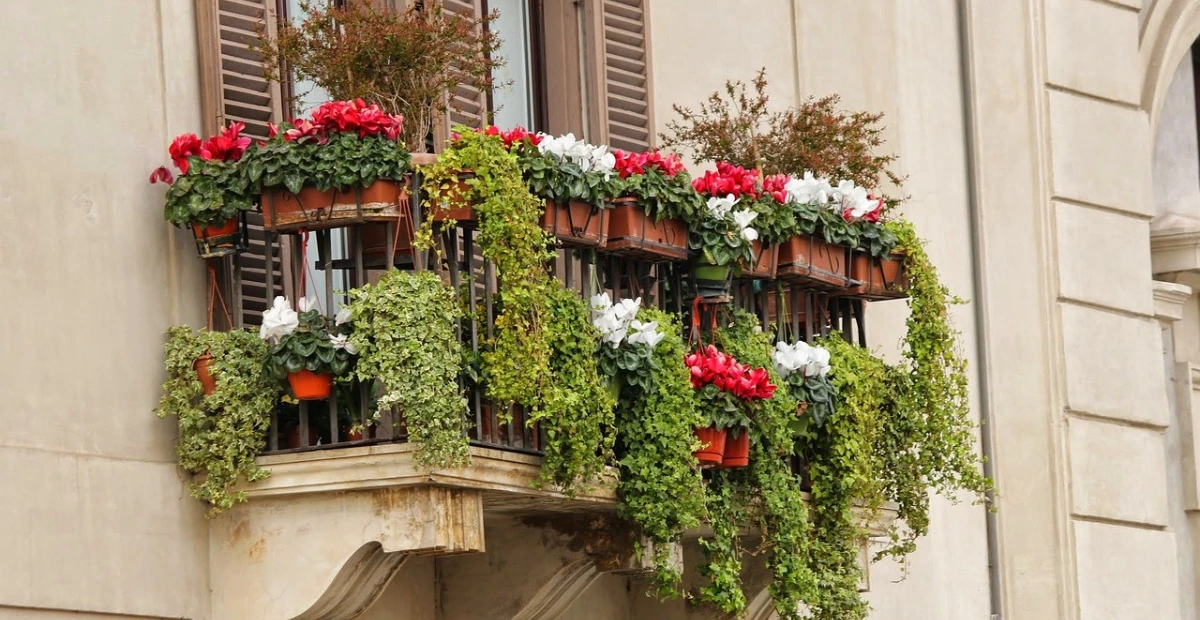Balconies—often overlooked as simple outdoor spaces—hold incredible potential to become lush, vibrant retreats. Whether you live in a bustling city apartment or a cozy suburban home, transforming your balcony into a beautiful garden can be both rewarding and therapeutic. Imagine stepping outside into a peaceful sanctuary, surrounded by greenery and colorful blooms, where you can relax after a busy day or host a garden-inspired gathering.
advertisement
Creating a stunning balcony garden doesn’t have to be a daunting task. With the right approach, you can turn even the smallest balcony into a thriving outdoor space that reflects your personality and enhances your lifestyle. In this guide, you’ll find easy, actionable tips for designing, planting, and maintaining your balcony garden—regardless of space or gardening experience.
Table of Contents
Key Considerations Before Starting Your Balcony Garden
Assessing Your Space: Size and Layout Matter
Before diving into the world of plants and decorations, it’s essential to assess the space you’re working with. Every balcony is unique—whether it’s a small, shaded corner or a spacious outdoor extension of your living room. Understanding the specific characteristics of your balcony will help you choose plants that thrive and create a harmonious layout.
advertisement
- Measure the Space: Take measurements of your balcony to better understand its size. Note the width, length, and height to maximize every inch of available space.
- Sunlight Exposure: Determine how much sunlight your balcony receives throughout the day. Does it get full sun (at least 6 hours of sunlight daily)? Or is it shaded for much of the day? This will guide your plant choices. For instance, sun-loving plants like geraniums and lavender need more sunlight, while ferns and ivy thrive in the shade.
- Wind and Weather Conditions: Wind can be a significant factor for balcony gardens. If you’re located in a windy area, you may need to choose sturdy plants and consider protecting them with screens or windbreaks.
- Access to Water: Ensure your balcony has easy access to water. If your water source is far, consider investing in a watering can or hose attachment, as well as watering systems like drip irrigation to keep plants hydrated.
By understanding these factors, you can create a balanced space where your plants will flourish and your balcony remains comfortable to use year-round.
Selecting the Right Plants for Your Balcony Garden
Choose Plants Based on Your Climate and Conditions
The success of your balcony garden heavily depends on the plants you select. When choosing plants, consider your balcony’s climate, sun exposure, and the amount of care you can commit to. Don’t be afraid to experiment, but keep these factors in mind for long-term success.
advertisement
Seasonal Plants
Seasonal plants are a great way to keep your balcony garden fresh and exciting throughout the year. These plants bloom at specific times of the year and can bring vibrant color to your space.
- Spring: Consider tulips, daffodils, or hyacinths for an early burst of color.
- Summer: Geraniums, petunias, and marigolds are perfect for a summer bloom.
- Fall: Incorporate chrysanthemums, pansies, or asters for autumn flair.
- Winter: Evergreens, such as holly and ivy, bring greenery during the colder months.
Drought-Resistant Plants
If you’re looking for low-maintenance options, drought-resistant plants are a great choice. These plants require less frequent watering, making them ideal for busy gardeners or those with limited access to water.
- Succulents: Aloe vera, jade plants, and echeveria are hardy and require minimal attention.
- Lavender: In addition to being drought-tolerant, lavender offers a lovely fragrance and attracts pollinators.
- Herbs: Rosemary, thyme, and oregano are excellent drought-resistant herbs that can thrive in smaller pots.
advertisement
Edible Balcony Garden
Growing your own herbs, fruits, or vegetables is not only a fun hobby but also adds a practical touch to your garden. Fresh basil, mint, or even small tomato plants can flourish on your balcony.
- Herbs: Basil, oregano, parsley, and thyme are easy to grow and perfect for culinary use.
- Vegetables: Try growing compact varieties of vegetables like peppers, spinach, and lettuce, which can thrive in containers.
- Fruit: Strawberries and dwarf fruit trees like lemon trees or apple trees can be grown in larger pots or containers.
By choosing plants suited to your balcony’s environment, you’ll set yourself up for success and create a garden that’s both beautiful and functional.
Essential Gardening Tools for Balcony Gardens
Must-Have Tools for Balcony Garden Success
Having the right tools on hand makes maintaining your balcony garden much easier. With a few key pieces of equipment, you’ll be able to care for your plants efficiently and effectively.
- Small Trowel: A small hand trowel is essential for digging and transferring soil.
- Watering Can: A watering can with a long spout allows you to reach difficult areas without spilling water.
- Pruning Shears: Regular trimming is necessary to remove dead foliage and encourage healthy growth.
- Planters and Pots: Use planters with proper drainage holes to prevent root rot. Consider self-watering planters to reduce the frequency of watering.
- Soil and Compost: Invest in high-quality soil and compost to provide your plants with the nutrients they need to thrive.
advertisement
Organizing Your Tools and Supplies
Since space is often limited on balconies, it’s important to organize your tools and supplies efficiently.
- Vertical Storage: Use wall-mounted racks or shelves to keep your tools off the floor and within easy reach.
- Weatherproof Containers: Ensure that any storage containers or bins are weatherproof to protect your gardening supplies from the elements.
By equipping yourself with these essential tools, you’ll be ready to take on any gardening task and keep your balcony garden flourishing.
Creating Stunning Designs and Layouts for Your Balcony Garden
Design with Layers and Height
One of the best ways to add visual interest to your balcony garden is by incorporating varying heights and textures. Rather than placing all your plants on the ground, think vertically and create layers of plants, accessories, and furniture.
- Vertical Gardening: Use hanging baskets, wall-mounted planters, or trellises to grow climbing plants like vines, peas, or tomatoes. These will free up space on the ground and add dimension to your design.
- Layering Plants: Place taller plants in the back, like small shrubs or ornamental grasses, and use smaller flowers and herbs in the front. This creates a natural flow and allows each plant to shine.
- Incorporating Furniture: Add furniture that complements the garden design. Choose lightweight, weather-resistant seating or small tables where you can enjoy your outdoor space.
advertisement
By layering your plants and arranging them thoughtfully, you can create a garden that’s visually stunning and makes the most of your limited space.
Maximize Your Space
Balconies often present space constraints, but that doesn’t mean you have to compromise on style or functionality. Here are a few tips for making the most of every inch of your outdoor space:
- Rail Planters: Utilize the railing of your balcony by installing narrow planters along the edge. This creates space for flowers, herbs, or even small vegetables.
- Multi-Functional Furniture: Choose furniture pieces that also serve a dual purpose. For example, a bench with hidden storage or a table with integrated planters can save space and enhance the garden’s functionality.
- Hanging Gardens: Hang plants from the ceiling or a wall bracket to free up floor space. You can create a floating garden effect, especially with trailing plants or cascading flowers.
By thinking creatively, you can ensure that every corner of your balcony is utilized to its full potential.
advertisement
Maintaining Your Balcony Garden Throughout the Year
Regular Care and Maintenance Tips
A balcony garden requires consistent care, but don’t worry—once you get into a routine, it becomes second nature. Here are a few maintenance tips to help you keep your balcony garden healthy and thriving.
- Watering: Depending on the season and the plants you have, watering needs will vary. During hot summer months, your plants may require daily watering, while in the cooler months, you may only need to water once or twice a week. Always check the soil before watering—plants prefer consistent moisture, but they don’t like sitting in soggy soil.
- Pruning and Deadheading: Regular pruning will help your plants grow stronger and prevent overcrowding. Deadheading, or removing dead flowers, encourages new blooms and keeps your garden looking fresh.
- Fertilizing: Use a balanced, slow-release fertilizer to give your plants the nutrients they need. Fertilizing every 4-6 weeks during the growing season is ideal.
Seasonal Considerations
Every season brings new challenges and opportunities for your balcony garden.
- Winter: Protect sensitive plants from frost by moving them indoors or using frost covers. Consider adding winter plants, like holly or ornamental cabbage, to keep your garden vibrant.
- Spring: Spring is the perfect time to refresh your garden. Trim back dead growth, replace the soil in your pots, and plant new seasonal flowers to breathe new life into your space.
By following these maintenance tips, your balcony garden will continue to flourish throughout the year.
Balcony Garden Design Ideas to Inspire You
advertisement
Creative Design Concepts
Need some inspiration? Here are a few unique design ideas to spark your creativity:
- Urban Jungle: Create an exotic atmosphere with tropical plants like palms, ferns, and orchids. This design can work in any city apartment, bringing a sense of nature to your urban environment.
- Zen Garden: Incorporate minimalistic design elements, like bamboo, bonsai trees, and stone features, to create a tranquil, calming space.
- Flower Paradise: Fill your balcony with a variety of vibrant flowers to create a colorful, lively garden that will make your space feel like a flower shop.
No matter what style resonates with you, your balcony garden should reflect your personal taste and bring joy to your outdoor experience.
Conclusion: Start Your Balcony Garden Today
Creating a beautiful balcony garden is within reach for everyone—no matter how much space or gardening experience you have. By following the tips and ideas in this guide, you can transform your balcony into a stunning outdoor retreat that enhances your lifestyle. Whether you’re planting vibrant flowers, growing your own herbs, or creating a peaceful zen garden, the possibilities are endless.
Don’t wait—take the first step today by assessing your space and selecting the perfect plants for your balcony. Your personal garden oasis is just a few simple steps away!
By incorporating these strategies, this article is designed to be both engaging and SEO-friendly, naturally integrating key terms like “balcony garden” and providing valuable content that readers will find useful. The call to action encourages readers to get started on their own balcony garden journey and make the most of their outdoor space.


